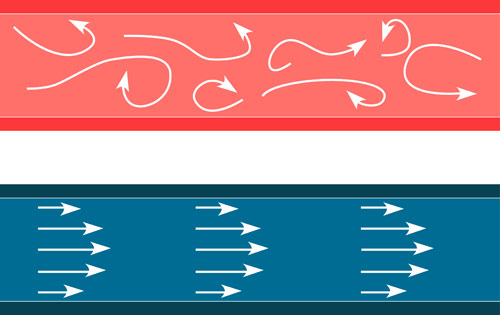A fluid is unique in its capacity to be, well … fluid. A solid is solid because its molecules enjoy staying put. A granite molecule joins hands with its molecular friends, where they have to stare at each other for millions, if not billions of years. Fluid molecules—remember that gases and liquids are both fluids—are not so particular with whom they associate, and they are perfectly happy with casual, fleeting relationships. In fact, fluid molecules are always in motion, unless and until they enter a solid state. Fluid molecules are easy to set in motion and difficult to stop, which is why they are perfect for fluid power. It’s easy to make a fluid “flow,” as it were.

As easily as fluid molecules move, they do have a preferred method of travel. If you work with dynamic pumps, laminar flow is a term you’re familiar with. Dynamic pump applications use the velocity of fluid (typically a liquid) to achieve work, which is why the term hydrodynamic is used. Because fluid velocity is as important as fluid pressure, a hydrodynamic system must consider the ease in which the fluid flows. Laminar flow describes this ease of flow, and it describes how the desire of a fluid to travel is parallel straight lines, whenever possible.
When fluid is prevented from this streamline flow, it experiences turbulence. Turbulence is the effect of fluid molecules bouncing, circling and reflecting in directions other than their desired path, and this turbulence is a huge energy waster. In hydrodynamic applications, the net effect of non-laminar flow is pressure drop. Bends, elbows, joints and even the surface finish of the conduit can reduce laminar flow and increase pressure drop. Reducing pressure drop in hydrodynamic applications is a top consideration when designing applications because as much energy as possible should be conserved for useful work, rather than overcoming turbulence.
But what about hydrostatic applications? Does the hydraulic industry need to consider the preservation of laminar flow at all costs? The easy answer is “it depends.” The difficult answer is going to require a little bit of math. Let’s consider two applications, one hydrodynamic and the other hydrostatic. Let’s take equal fluid horsepower output (100% efficiency for argument’s sake) of five, and we’ll split the energy up for each based on 120 psi hydrodynamic and 3,000 psi hydrostatic pressure:
120 psi x 71 gpm / 1714 = 5 hp Hydrodynamic
3000 psi x 2.86 gpm / 1714 = 5 hp Hydrostatic
So in our fictional 5-hp examples, the hydrodynamic application can pump 71 gpm at our pressure limit, and the hydrodynamic application can achieve less than 3 gpm. Let us throw turbulence into the mix, and give each example 60 psi worth of pressure drop related to the poor plumbing of their systems. This 60 psi of pressure drop is the result of measuring pressure at the pump and then at our actuator. Our subsequent power calculation occurs at the actuator, not at the pump.
(120 psi – 60 psi) x 71 gpm / 1714 = 2.5 hp Hydrodynamic
(3000 psi – 60 psi) x 2.86 gpm / 1714 = 4.9 hp Hydrostatic
So with the same pressure drop, the hydrodynamic application will lose half of its power potential compared to just a fraction for the hydrostatic application. So much of the work in a hydraulic application is via pressure, not flow, and the result is that laminar flow is nowhere near as important. The exception may be with very large flow systems, where a large amount of energy can be lost due to overcoming flow. However, even in those situations, the energy lost is still a small percentage, which is why pressure drop can be in the hundreds of psi and cause few worries. You won’t do any harm in trying to achieve laminar flow in your hydraulic system, but the effort in most cases isn’t worth the payoff.

